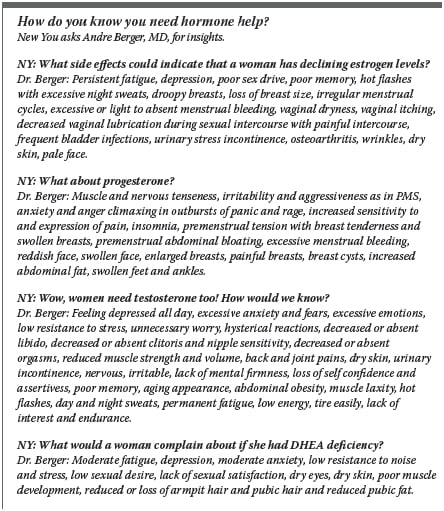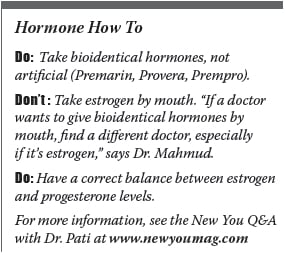By: Eliza Drewa
Ladies, in the quest to optimize the way we look and feel, it pays to be smart about hormones
There was no “Sex in the City” for sexy Samantha Jones (Kim Cattrall) when, in the second cinematic feature, she entered Abu Dhabi and had her hormone-enhancing drugs confiscated under UAE law, rendering her devoid of estrogen and hence her famous libido. Back in New York she’d discovered the answer to dealing with the classic menopausal symptoms of hot flashes, mood swings and a low-sex drive: Bioidentical hormone replacement therapy, or BHRT.
Bioidentical hormone replacement therapy simply is just what it sounds like: replacing and balancing the body’s natural hormone levels with hormones that are identical to those found in humans. Over the past decade there has been some confusion and controversy regarding the safety of the therapy. So in the name of all that looks good and FEELS good, ladies, we’re bringing you the real deal on hormone therapy—especially for women.
To Replace Or Not To Replace?
To answer this question, you’ve got to understand the role hormones play within the body.
According to Sangeeta Pati, MD, an Orlando-based authority in hormone replacement, the reason we replace hormones is obvious. “Every single organ in the body has a receptor for all these hormones we’re talking about. Every brain cell, every heart cell and every skin cell. And with every passing year, from 25 onwards, we start to see a real decline of these hormones.”
Hormones play an important role in maintaining these organs. But to do so, they have to be at optimal levels. The slightest imbalance, she says, can affect your organs and begin the degeneration process, which might not become physically apparent for, say, 10 or 15 years. Hence it is important to balance and maintain optimal hormone levels early to prevent gradual “aging” that will show up later in the form of aches, pains, cardiovascular problems and bone health to name a few.
And for women, changing hormone levels also signals the approach of menopause.
“For most women, skipping twelve periods in a row officially confirms that they have reached menopause. Most women reach menopause by age 51 to 55. Menopause is preceded by the perimenopause phase that can last as long as ten years, although it’s usually shorter,” explains Andre Berger, MD, founder of Rejuvalife Vitality Institute in Beverly Hills, Calif.
During this pre-menopause phase some periods may be heavier than others, according to Dr. Berger.
“This happens because the fall in the levels of progesterone and estrogen signals the uterus to shed its endometrial lining prematurely, and this may happen even before perimenopause,” he says.
Often, the first signs that perimenopause has started are shorter cycles, irregular cycles or both. Interestingly, during this time, testosterone will also decline, says Dr. Berger, but in many women at a much slower rate than progesterone and estrogen. The ovaries will continue to secrete testosterone even after menopause.
“A woman’s body responds to the changing hormone balance of perimenopause because estrogens and progesterone have profound effects. These effects include hot flashes, insomnia, depression, forgetfulness, other mood changes, night sweats, noticeable skin aging and a general dryness and thinning of the vaginal area,” says Dr. Berger.
Experts agree: “Hot flashes, night sweats, trouble sleeping, low energy, brain fog, decreased libido—the pleasures of life are gone,” says Khalid Mahmud, MD, a doctor who practices anti-aging medicine in Minneapolis, Minn.
Even more seriously, says Dr. Pati, “Years later, when we start to experience the lack of stimulation to those organs, we start to see the diseases—the bone loss, the cognitive loss, the strokes.” She believes the question isn’t “How safe is it to use hormone replacement?” but “How safe is it NOT to?”
Using bioidentical hormones (estrogen and progesterone) in the correct amounts, at the right times, mimics the natural ups and downs of the body’s own hormones and causes the body to respond as if the ovaries were still functioning normally, alleviating these unpleasant symptoms of perimenopause.
Put that way, the important role of hormone replacement in the quest to “anti”-age seems obvious. But not all hormones are the same, and it’s also possible to take them the wrong way—both issues that could lead to problems down the road as demonstrated in a large clinical trial that gave HRT a black eye nearly 10 years ago: The Women’s Health Initiative (WHI).
HRT VS BHRT
In the WHI study, investigators found that the associated health risks of combined estrogen plus progestin (the pharmaceutical version of progesterone) hormone therapy outweighed the benefits. The study was stopped in 2002 because of increased cardiovascular disease and breast cancer in study participants.
“After much evaluation and dissection of the original research, it was found that the WHI study was done with synthetic hormones,” says Dr. Pati. But, “There have been multiple studies with bioidentical hormones since that time that indicate that bioidentical hormones do not share the same problems that synthetic hormones do.”
In a published review of clinical studies that compared the effects of bioidentical and synthetic hormones, including clinical outcomes, endocrinologist Kent Holtorf, MD, reported in his paper “The Bioidentical Hormone Debate” that bioidentical hormones are associated with lower risks, including the risk of breast cancer and cardiovascular disease, and provide better results than their synthetic and animal-derived counterparts.
So what’s the difference between bioidentical and synthetic hormones? Technically, says Dr. Mahmud, all hormones are synthetic. The real issue is their molecular structure. “All hormones can be synthesized. They’re all synthesized whether bioidentical or not. ‘Bioidentical’ means [hormones are molecularly] identical to what’s in the body.”
Part of the confusion came from weak reporting by the press. “Generally when media and even journals provide information about hormones, they refer to HRT (hormone replacement therapy) as one treatment, when we know there are several different types of estrogens,” says Dr. Pati.
Some of those estrogens are harmful and some of them are protective.
According to Dr. Berger, “One type is patentable and synthetic and non- bioidentical and harmful, and another is natural and bioidentical and protective.”
As for progesterone, says Dr. Mahmud, “A great deal of confusion surrounds the topic of whether progesterone causes cancer. This is because when we speak of progesterone, we lump all the progestogens into one group, but there are critical [biochemical] molecular differences which make natural bioidentical progesterone protective, and synthetic non bioidentical [patentable] progesterone harmful.”
Benefit VS Risk
So let’s take a look at just what this difference is. If we look at progesterone, for example, the synthetic version is medroxyprogesterone, often prescribed as Provera, essentially a “look-alike” with a similar molecular structure to progesterone. Not truly a progesterone, medroxyprogesterone is a progestin or progestogen, the form of synthetic, patentable, non bioidentical progesterone that was used in the WHI study, explains Dr. Mahmud.
Despite the fact that Provera and Progesterone have very similar chemical structures they also have some important differences that account for many of the unwanted effects that Provera and similar drugs cause, according to Dr. Berger.
“Women have been asked to take a risk with their lives when they have used synthetic hormones such as Premarin or Provera to ease the symptoms of perimenopause and menopause by accepting a small risk of cancer in exchange for relieving their unpleasant associated symptoms, as well as a larger chance of preventing atherosclerosis, osteoporosis and, possibly, memory loss. The use of bioidentical hormones in the correct proportions at the correct times provides all the benefits and greatly decreases a woman’s risk,” says Dr. Berger.
According to Dr. Pati, the cardiac literature has dozens of studies showing the protective effect of bioidentical transdermal progesterone on vascular function and therefore clots, heart attacks and strokes.
“If you use the progesterone molecule, which is identical to the one the body has, there is a protective effect against cancer, heart attacks and clots,” says Dr. Pati.
The key is using what the body recognizes. If it’s identical, it’s protective. “Bioidentical estrogen and progesterone provide all of the benefits of the synthetic forms, and more, with many fewer side effects, while increasing the risk of endometrial or breast cancer very little, if at all,” says Dr. Berger.
More Than Mere Replacement
The type (molecular structure) of hormone you take is one thing, but there’s also the issue of taking it the right way.
“Don’t take estrogen by mouth; don’t take testosterone by mouth,” says Dr. Mahmud. “It will go into the liver first. Even then, you have to monitor the levels. Too much or too little creates problems.”
If you’re a woman approaching menopause and have all the symptoms, Dr. Mahmud’s advice is to see a doctor who understands anti-aging medicine. But he also emphasizes the importance of finding a doctor who is cautious. “You have to give hormones in a natural manner, not being bombarded [with hormones], which could cause breast cancer.”
The bottom line? Approach with caution. Find the right doctor. And heed Dr. Mahmud’s lessons learned from the WHI study: “We learned a couple of things from that big study. Start early, mimic the normal ratios, use a trans-dermal route, don’t use an oral route and use a bioidentical progesterone.”















